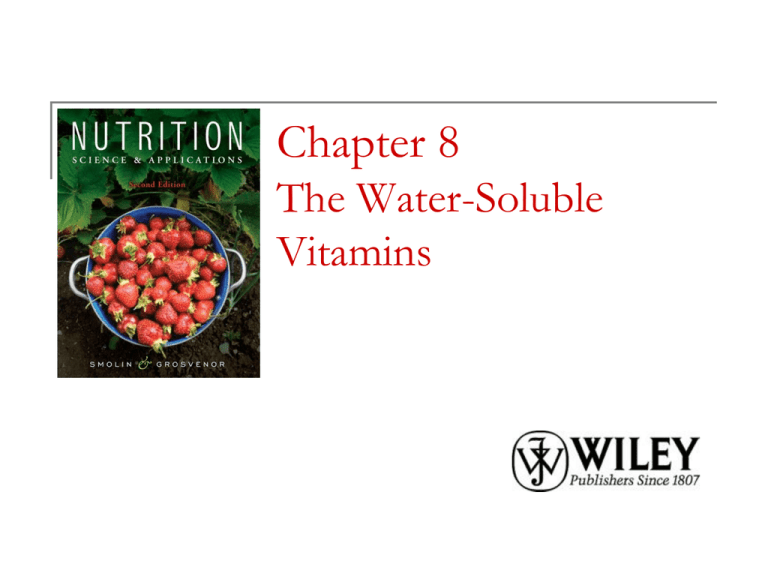
Chapter 8
The Water-Soluble
Vitamins
Vitamin Talk
Vitamins are organic compounds essential in
the diet to promote growth and health
maintenance.
Water-soluble vitamins include the B
vitamins and vitamin C.
Fat-soluble vitamins include A, D, E and K.
B vitamins were originally thought to be one
chemical substance but are actually many
different substances. That is the reason for
B1, B2, B12, etc.
Copyright 2010, John Wiley & Sons, Inc.
The Vitamins
Copyright 2010, John Wiley & Sons, Inc.
Finding Vitamins in Foods
Copyright 2010, John Wiley & Sons, Inc.
Fortified and Enriched Foods
Fortification: process of adding nutrients to
foods. The added nutrients are generally not
found in the food, such as fortifying orange
juice with calcium.
Enrichment: adding nutrients back to foods
that have lost nutrients due to processing.
An example is the addition of B vitamins to
white rice.
Copyright 2010, John Wiley & Sons, Inc.
Dietary Supplements
Dietary supplements can be another source
of vitamins in the modern diet.
Dietary supplements contain some
combination of vitamins, minerals, herbs,
botanicals, amino acids, enzymes or
extracts.
Dietary supplements cannot replace the
benefits of a diet containing a wide variety of
foods.
Dietary supplement production is not
supervised by the FDA.
Copyright 2010, John Wiley & Sons, Inc.
Absorption
of Vitamins
Copyright 2010, John Wiley & Sons, Inc.
Bioavailability of Vitamins
Vitamins must be absorbed by the body in order to
perform their functions.
Approximately 40-90% of vitamins are absorbed in
the small intestine.
Fat-soluble vitamins require fat in the diet to be
absorbed.
Water-soluble vitamins may require transport
molecules or specific molecules in the GI tract.
Some vitamins are absorbed in inactive provitamin
or vitamin precursor forms that must be converted
into active forms by the body.
Copyright 2010, John Wiley & Sons, Inc.
Folate Deficiency and Neural Tube
Defects
Copyright 2010, John Wiley & Sons, Inc.
Macrocytic Anemia and Folate
Deficiency
Copyright 2010, John Wiley & Sons, Inc.
How Antioxidants Work
Copyright 2010, John Wiley & Sons, Inc.
Summary of Water-Soluble Vitamins
and Choline
Copyright 2010, John Wiley & Sons, Inc.
Copyright 2010, John Wiley & Sons, Inc.
Benefits and Risks of Water-Soluble
Vitamin Supplements
Copyright 2010, John Wiley & Sons, Inc.
Chapter 8
Copyright 2010 John Wiley & Sons, Inc.
All rights reserved. Reproduction or translation of this work beyond
that permitted in section 117 of the 1976 United States Copyright Act
without express permission of the copyright owner is unlawful.
Request for further information should
be addressed to the
.
Permissions Department, John Wiley & Sons, Inc. The purchaser may
make back-up copies for his/her own use only and not for distribution
or resale. The Publisher assumes no responsibility for errors,
omissions, or damages caused by the use of these programs or from
the use of the information herein.
Copyright 2010, John Wiley & Sons, Inc.
Chapter 9
The Fat-Soluble
Vitamins
Fat-Soluble Vitamins
Vitamins A, D, E and K are fat-soluble vitamins.
Fat-soluble vitamins require bile and dietary fat for
absorption.
Once absorbed, they are transported with fats
through the lymphatic system in chylomicrons
before entering the blood.
Fat-soluble vitamins can be stored in body fat,
meaning that intakes can vary without a risk of
deficiency (as long as there are average intakes
over time).
Because they can be stored in body fat, fat-soluble
vitamins are not easily excreted. This increases the
risk of toxicity with high intakes.
Copyright 2010, John Wiley & Sons, Inc.
Vitamin D
from UV
Light or the
Diet
Copyright 2010, John Wiley & Sons, Inc.
A Summary of the Fat-Soluble Vitamins
Copyright 2010, John Wiley & Sons, Inc.
A Summary of the Fat-Soluble Vitamins
Copyright 2010, John Wiley & Sons, Inc.
Benefits and Risks of Fat-Soluble
Vitamin Supplements
Copyright 2010, John Wiley & Sons, Inc.
Chapter 10
Water and the
Electrolytes
Water
Water is an essential nutrient that must be
consumed for survival.
Water is a polar solvent in the body.
The polarity of water comes from hydrogen
and oxygen.
Blood is 90% water.
Blood transports oxygen and nutrients to
cells and removes carbon dioxide and waste
products.
Copyright 2010, John Wiley & Sons, Inc.
Water
Water functions as a lubricant and cleanser.
Tears wash away dirt, synovial fluid
lubricates joints, saliva assists in chewing,
tasting and swallowing and spinal fluid
protects against shock.
Water assists in regulating body temperature
by holding onto heat and changing
temperature slowly.
Copyright 2010, John Wiley & Sons, Inc.
Need for Water in the Body
Compared to Intake
Copyright 2010, John Wiley & Sons, Inc.
Resources for Water in the Diet
Copyright 2010, John Wiley & Sons, Inc.
Antidiuretic
Hormone
Assists in
Fluid Intake
Copyright 2010, John Wiley & Sons, Inc.
Consequences
of Dehydration
Copyright 2010, John Wiley & Sons, Inc.
Electrolytes: Sodium, Potassium and
Chloride
The correct combination and amounts of
electrolytes are essential for life.
Distribution of electrolytes affects the
distribution of water throughout the body.
Sodium, potassium and chloride are the
principle electrolytes in body fluids.
Copyright 2010, John Wiley & Sons, Inc.
Summary of Water and the Electrolytes
Copyright 2010, John Wiley & Sons, Inc.
Chapter 10
Copyright 2010 John Wiley & Sons, Inc.
All rights reserved. Reproduction or translation of this work beyond
that permitted in section 117 of the 1976 United States Copyright Act
without express permission of the copyright owner is unlawful.
Request for further information should
be addressed to the
.
Permissions Department, John Wiley & Sons, Inc. The purchaser may
make back-up copies for his/her own use only and not for distribution
or resale. The Publisher assumes no responsibility for errors,
omissions, or damages caused by the use of these programs or from
the use of the information herein.
Copyright 2010, John Wiley & Sons, Inc.
Chapter 11
Major Minerals and
Bone Health
Minerals in the Body
Minerals are elements needed by the body
in small amounts for health and
maintenance.
Major minerals are needed in the diet in
amounts greater than 100 mg per day or are
present in the body in amounts greater than
0.01% of body weight.
Trace minerals are required in the diet in
amounts less than 100 mg per day or are
present in the body in amounts less than
0.01% of body weight.
Copyright 2010, John Wiley & Sons, Inc.
Minerals
Copyright 2010, John Wiley & Sons, Inc.
Minerals in the Diet
Copyright 2010, John Wiley & Sons, Inc.
Mineral Talk
Minerals are available in unprocessed foods, some
processed foods and dietary supplements.
To maintain health, minerals must be consumed in the
correct proportions.
Bioavailability is very important. For example, phytates
can limit the body’s ability to absorb calcium, zinc and iron.
DRIs for minerals are expressed as RDAs, EARs or AIs.
Because certain minerals can be toxic if taken in too high an
amount, ULs have been established.
Copyright 2010, John Wiley & Sons, Inc.
Osteoporosis Risk
Copyright 2010, John Wiley & Sons, Inc.
Gender and Bone Mass
Copyright 2010, John Wiley & Sons, Inc.
Summary of Calcium, Phosphorus,
Magnesium and Sulfur
Copyright 2010, John Wiley & Sons, Inc.
Chapter 11
Copyright 2010 John Wiley & Sons, Inc.
All rights reserved. Reproduction or translation of this work beyond
that permitted in section 117 of the 1976 United States Copyright Act
without express permission of the copyright owner is unlawful.
Request for further information should
be addressed to the
.
Permissions Department, John Wiley & Sons, Inc. The purchaser may
make back-up copies for his/her own use only and not for distribution
or resale. The Publisher assumes no responsibility for errors,
omissions, or damages caused by the use of these programs or from
the use of the information herein
Copyright 2010, John Wiley & Sons, Inc.
Chapter 12
The Trace Elements
Trace Elements Talk
The trace elements include iron, zinc,
copper, manganese, selenium, iodine,
fluoride, chromium and molybdenum.
They are required in amounts less than 100
mg per day.
Trace elements have been difficult to study,
as they are difficult to remove from the diet.
Rate of bioavailability is a concern for trace
elements.
Copyright 2010, John Wiley & Sons, Inc.
Iron Talk
Hemoglobin is the iron-containing component of the
blood.
Iron from animal products is heme iron.
Iron from plant products is nonheme iron.
Iron cookware can be a source of nonheme iron in the
diet.
Heme iron is more efficiently absorbed than nonheme
iron.
Iron from the diet is absorbed into the intestinal
mucosal cells.
Copyright 2010, John Wiley & Sons, Inc.
Heme Iron Absorption
Copyright 2010, John Wiley & Sons, Inc.
Iodine Talk
The iodine content of food depends on the soil where
plants are grown or where animals graze.
Soil near the ocean or sea is higher in iodine than soil
inland.
Most of the iodine in the diet comes from iodized salt.
Iodized salt is salt fortified with iodine. “Natural” sea salt
may be very low in iodine.
More than half the iodine in the body is found in the
thyroid gland.
Iodine is an essential component of thyroid hormones,
including thyroxine.
Copyright 2010, John Wiley & Sons, Inc.
Summary of Trace Elements
Copyright 2010, John Wiley & Sons, Inc.
Summary of Trace Elements
Copyright 2010, John Wiley & Sons, Inc.
Benefits and Risks of Trace Element
Supplements
Copyright 2010, John Wiley & Sons, Inc.
Chapter 12
Copyright 2010 John Wiley & Sons, Inc.
All rights reserved. Reproduction or translation of this work beyond
that permitted in section 117 of the 1976 United States Copyright Act
without express permission of the copyright owner is unlawful.
.
Request for further information should
be addressed to the
Permissions Department, John Wiley & Sons, Inc. The purchaser may
make back-up copies for his/her own use only and not for distribution
or resale. The Publisher assumes no responsibility for errors,
omissions, or damages caused by the use of these programs or from
the use of the information herein.
Copyright 2010, John Wiley & Sons, Inc.




